Related Research Articles
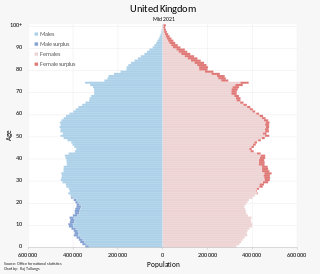
The population of the United Kingdom was estimated at over 67.0 million in 2020. It is the 21st most populated country in the world and has a population density of 270 people per square kilometre, with England having significantly greater density than Wales, Scotland, and Northern Ireland. Almost a third of the population lives in South East England, which is predominantly urban and suburban, with about 9 million in the capital city, London, whose population density is just over 5,200 per square kilometre.

The London Borough of Redbridge is a London borough established in 1965.

Demographics of Wales include the numbers in population, place of birth, age, ethnicity, religion, and number of marriages in Wales.

The demography of England has since 1801 been measured by the decennial national census, and is marked by centuries of population growth and urbanization. Due to the lack of authoritative contemporary sources, estimates of the population of England for dates prior to the first census in 1801 vary considerably. The population of England at the 2021 census was 56,489,800.

The Department for Digital, Culture, Media and Sport (DCMS) is a department of His Majesty's Government, with responsibility for culture and sport in England, the building of a digital economy, and some aspects of the media throughout the UK, such as broadcasting and the Internet.
A nationwide census, known as Census 2001, was conducted in the United Kingdom on Sunday, 29 April 2001. This was the 20th UK census and recorded a resident population of 58,789,194.

Religion in the United Kingdom, and in the countries that preceded it, has been dominated for over 1,000 years by various forms of Christianity, replacing Romano-British religions, Celtic and Anglo-Saxon paganism as the primary religion. Religious affiliations of United Kingdom citizens are recorded by regular surveys, the four major ones being the national decennial census, the Labour Force Survey, the British Social Attitudes survey and the European Social Survey.
The Barnett formula is a mechanism used by the Treasury in the United Kingdom to automatically adjust the amounts of public expenditure allocated to Northern Ireland, Scotland and Wales to reflect changes in spending levels allocated to public services in England, Scotland and Wales, as appropriate. The formula applies to a large proportion, but not the whole, of the devolved governments' budgets − in 2013–14 it applied to about 85% of the Scottish Parliament's total budget.
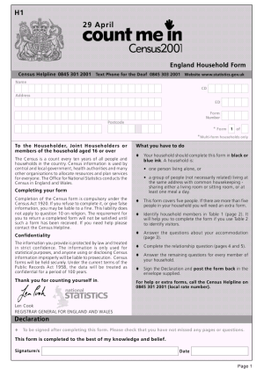
Coincident full censuses have taken place in the different jurisdictions of the United Kingdom every ten years since 1801, with the exceptions of 1941, Ireland in 1921/Northern Ireland in 1931, and Scotland in 2021. In addition to providing detailed information about national demographics, the results of the census play an important part in the calculation of resource allocation to regional and local service providers by the UK government.

The demography of Scotland includes all aspects of population, past and present, in the area that is now Scotland. Scotland has a population of 5,463,300, as of 2019. The population growth rate in 2011 was estimated as 0.6% per annum according to the 2011 GROS Annual Review.

The demography of London is analysed by the Office for National Statistics and data is produced for each of the Greater London wards, the City of London and the 32 London boroughs, the Inner London and Outer London statistical sub-regions, each of the Parliamentary constituencies in London, and for all of Greater London as a whole. Additionally, data is produced for the Greater London Urban Area. Statistical information is produced about the size and geographical breakdown of the population, the number of people entering and leaving country and the number of people in each demographic subgroup. The total population of London as of 2021 is 8,799,800.
British Jews are British citizens who identify as Jewish. The number of people who identified as Jews in England and Wales rose slightly between 2001 and 2021, with the growth being attributed to the higher birth rate of the Haredi community.
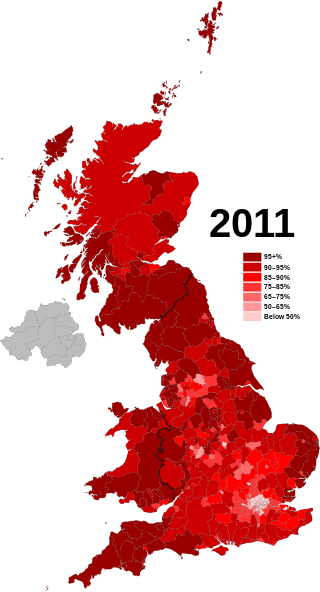
White British is an ethnicity classification used for the native white population identifying as English, Scottish, Welsh, Cornish, Northern Irish, or British in the United Kingdom Census. In the 2011 census, the White British population was 51,736,290, 81.88% of the UK total population.
Mixed is an ethnic group category that was first introduced by the United Kingdom's Office for National Statistics for the 2001 Census. Colloquially it refers to British citizens or residents whose parents are of two or more different races or ethnic backgrounds. The Mixed or Multiple ethnic group in England and Wales numbered 1.7 million in the 2021 census, 2.9% of the population.

The term Other White is a classification of ethnicity in the United Kingdom and has been used in documents such as the 2011 UK Census to describe people who self-identify as white persons who are not of the English, Welsh, Scottish, Romani or Irish ethnic groupings.

The United Kingdom of Great Britain and Northern Ireland (UK), since 1922, comprises three constituent provinces and 2 regions: England, Scotland, and Wales, as well as Northern Ireland, a region in its own right. The UK Prime Minister's website has used the phrase "countries within a country" to describe the United Kingdom. Some statistical summaries, such as those for the twelve NUTS 1 regions of the United Kingdom, refer to Northern Ireland, Scotland, and Wales as "regions". With regard to Northern Ireland, Scotland and Wales particularly, the descriptive name one uses "can be controversial, with the choice often revealing one's political preferences".
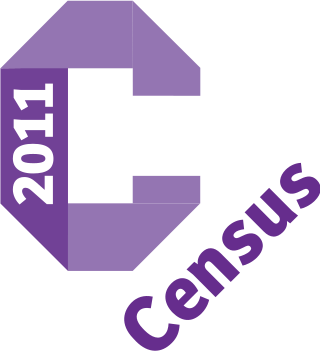
A census of the population of the United Kingdom is taken every ten years. The 2011 census was held in all countries of the UK on 27 March 2011. It was the first UK census which could be completed online via the Internet. The Office for National Statistics (ONS) is responsible for the census in England and Wales, the General Register Office for Scotland (GROS) is responsible for the census in Scotland, and the Northern Ireland Statistics and Research Agency (NISRA) is responsible for the census in Northern Ireland.

The decennial 2021 censuses of England and Wales and of Northern Ireland took place on 21 March 2021, and the census of Scotland took place on 20 March 2022. The censuses were administered by the Office for National Statistics (ONS) in England and Wales, by the Northern Ireland Statistics and Research Agency (NISRA) in Northern Ireland, and by the National Records of Scotland in Scotland. These were the first British censuses for which most of the data was gathered online, and two of them went ahead despite the COVID-19 pandemic, in part because the information obtained will assist government and public understanding of the pandemic's impact. Enumeration in Scotland was postponed, and took place in 2022, the plans for it having been delayed because of the pandemic.
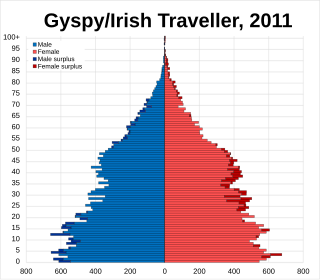
White: Gypsy or Irish Traveller is an ethnicity classification used in the 2011 United Kingdom Census. In the 2011 census, the White: Gypsy or Irish Traveller population was 63,181 or about 0.1 percent of the total population of the country. The ethnicity category may encompass populace from the distinct ethnic groups of Romanichal Travellers or Irish Travellers, and their respective related subgroupings, who identify as, or are perceived to be, white people in the United Kingdom.

Welsh, a Brythonic Celtic language, was historically spoken by the majority of Wales' population, with current estimates suggesting a third of the current population of Wales speak the language.
References
- 1 2 3 4 HoL Select Committee on the Barnet Formula, Paragraph 23, https://publications.parliament.uk/pa/ld200809/ldselect/ldbarnett/139/13907.htm
- ↑ National Assembly for Wales: The Barnett Formula: funding the devolved administrations, chapter 3, paragraph 1, http://www.assembly.wales/09-012.pdf
- ↑ IPPR: Fair Shares? Barnett and the politics of public expenditure , Box 3.1
- 1 2 3 "Archived copy". Archived from the original on 2015-10-23. Retrieved 2015-10-12.
{{cite web}}: CS1 maint: archived copy as title (link) - ↑ "Vision of Britain | 1921 Census: General | Table 1". www.visionofbritain.org.uk. Retrieved 2016-10-13.
- ↑ "National Archives - History of Irish census records". www.census.nationalarchives.ie. Retrieved 2016-10-13.
- ↑ ONS, Population Estimates for UK, England and Wales, Scotland and Northern Ireland, http://www.ons.gov.uk/ons/publications/re-reference-tables.html?edition=tcm%3A77-247414